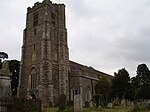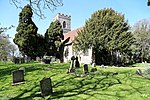Hatfield Broad Oak
Civil parishes in EssexHatfield Broad OakUse British English from June 2015UttlesfordVillages in Essex

Hatfield Broad Oak (also known as Hatfield Regis) is a village and civil parish in the Uttlesford district of Essex, England. The village is approximately 5 miles (8 km) south-east of Bishop's Stortford. Near the church of St Mary the Virgin is former Benedictine priory Hatfield Regis Priory.
Excerpt from the Wikipedia article Hatfield Broad Oak (License: CC BY-SA 3.0, Authors, Images).Hatfield Broad Oak
High Street, Uttlesford Hatfield Broad Oak
Geographical coordinates (GPS) Address Nearby Places Show on map
Geographical coordinates (GPS)
| Latitude | Longitude |
|---|---|
| N 51.82712 ° | E 0.24257 ° |
Address
High Street
CM22 7HG Uttlesford, Hatfield Broad Oak
England, United Kingdom
Open on Google Maps









